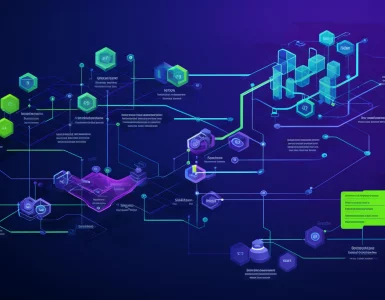In the world of databases, there are two major types that dominate the landscape: SQL (Structured Query Language) and NoSQL (Not only SQL).
Both SQL and NoSQL are used to manage and manipulate data, but they have different approaches and purposes.
In this blog, we will compare SQL and NoSQL, exploring their definitions, applications, and the key differences between them.
What is SQL?
SQL represents Structured Query Language. SQL is a domain-specific language typically used in programming and managing relational databases.
SQL allows users to interact with databases by defining, manipulating, and retrieving data. It provides a standardized way to communicate with a database management system (DBMS).
Applications of SQL
SQL, or Structured Query Language, finds its application in various domains, making it an essential tool for handling data in the digital age. Here are some of the key applications of SQL:
- Database Management: SQL is primarily used for managing relational databases. It enables users to create, modify, and delete database objects like tables, views, indexes, and constraints, ensuring efficient organization and storage of data.
- Data Retrieval: One of the fundamental uses of SQL is to fetch data from databases. The SELECT statement enables users to retrieve specific information based on specified criteria, making it easy to access and analyze relevant data.
- Data Manipulation: SQL provides commands like INSERT, UPDATE, and DELETE, which facilitate the manipulation of data in the database. This allows users to add new records, modify existing ones, or delete unnecessary data.
- Data Analysis: SQL plays a crucial role in data analysis and reporting. It enables users to aggregate and filter data, perform calculations, and generate meaningful insights using functions and advanced query techniques.
- Web Development: Many web applications and websites rely on SQL for backend data management. It allows developers to store and retrieve user information, product details, and other data needed for dynamic web pages.
- Business Intelligence: SQL is an integral part of business intelligence systems. It helps extract valuable insights from large datasets, assisting decision-makers in making informed choices and predicting trends.
- E-commerce: In online retail, SQL helps manage inventory, customer information, order processing, and transaction tracking, enabling smooth and efficient e-commerce operations.
- Mobile Apps: SQL is often used in mobile app development to handle local databases on devices. It allows apps to store and manage user data even when offline and sync with the central server when online.
- Data Integration: SQL is essential in data integration tasks, where data from multiple sources need to be combined and transformed into a cohesive format for analysis and reporting.
- Healthcare and Finance: SQL plays a crucial role in managing patient records, medical data, financial transactions, and auditing processes, ensuring accurate and secure data handling.
What is NoSQL?
NoSQL, or Not only SQL, is a type of database management system designed for unstructured or semi-structured data.
Unlike SQL databases, NoSQL databases do not use fixed table schemas. Instead, they use flexible data models such as key-value pairs, documents, graphs, or column stores.
NoSQL databases offer high scalability, availability, and performance at the expense of sacrificing some of the ACID properties of SQL.
Applications of NO SQL
NoSQL databases have gained popularity due to their ability to handle large volumes of unstructured or semi-structured data more efficiently than traditional relational databases. Here are some of the key applications of NoSQL databases:
- Big Data and Real-Time Analytics: NoSQL databases are well-suited for handling massive amounts of data generated by applications, IoT devices, social media, and other sources. They allow for fast and scalable data storage and processing, enabling real-time analytics and insights.
- Web Applications: NoSQL databases are commonly used in web applications, especially those dealing with user-generated content, social networks, and online gaming. They can handle unpredictable and rapidly changing data with ease.
- Content Management Systems (CMS): CMS platforms often use NoSQL databases to manage and serve large amounts of content, including text, images, videos, and other media files.
- Mobile Apps: NoSQL databases are popular in mobile app development for handling offline data storage, synchronization, and seamless scaling to accommodate growing user bases.
- Internet of Things (IoT): NoSQL databases are ideal for IoT applications, where devices generate a vast amount of data that requires rapid storage and retrieval.
- Time-Series Data: NoSQL databases are well-suited for managing time-series data, such as logs, sensor readings, financial data, and monitoring information.
- Graph Data: NoSQL graph databases are specifically designed to store and traverse graph-like data structures, making them suitable for social networks, recommendation engines, and network analysis.
- E-commerce and Recommendation Engines: NoSQL databases can efficiently handle the diverse and constantly changing data found in e-commerce platforms, making them ideal for recommendation systems.
- Gaming and Entertainment: NoSQL databases are commonly used in online gaming platforms, digital media distribution, and content streaming services due to their ability to handle high traffic and dynamic data.
- Distributed Systems: NoSQL databases are a natural fit for distributed and cloud-based systems, as they are designed to scale horizontally across multiple nodes and data centres.
SQL vs NoSQL
Here are the key differences between SQL and NoSQL databases:
Data Model:
- SQL databases are based on a relational data model. Here data is organized into tables with predefined schemas. Each row in a table represents a record, and relationships between tables are defined by primary and foreign keys.
- NoSQL databases use various data models, including key-value, document, column-family, and graph models. They are more flexible and can handle unstructured or semi-structured data.
Schema:
- SQL databases have a fixed schema, which means that the structure of the data must be defined in advance, and any changes to the schema require altering the tables.
- NoSQL databases typically have a dynamic or schema-less approach, allowing you to store different types of data without a predefined schema. This flexibility is beneficial when dealing with rapidly changing or diverse data.
Scaling:
- SQL databases are traditionally designed for vertical scaling, where you upgrade hardware to handle increased data and traffic. Scaling up can be expensive and has limitations.
- NoSQL databases are designed for horizontal scaling, allowing you to add more servers or nodes to distribute the data and traffic. This approach is generally more cost effective and provides better scalability for large-scale applications.
Transactions and ACID Properties:
- SQL databases are known for providing strong ACID (Atomicity, Consistency, Isolation, Durability) properties, ensuring data integrity and reliability in transactions.
- NoSQL: NoSQL databases often sacrifice some ACID properties in favour of higher scalability and performance. While some NoSQL databases offer limited ACID guarantees, others focus on eventual consistency in distributed environments.
Query Language:
- As the name suggests, SQL databases use the SQL language for data manipulation and retrieval. SQL provides a standardized way to interact with relational databases.
- NoSQL databases have varying query languages depending on their data model. Some use a query language similar to SQL for document-based databases, while others use key-value access or graph-based traversal languages.
Use Cases:
- SQL databases are well-suited for applications with structured data and complex relationships, such as financial systems, inventory management, and reporting applications.
- NoSQL databases excel in scenarios with large volumes of unstructured or semi-structured data, real-time analytics, content management systems, social networks, and IoT applications, where high scalability and flexibility are critical.
Data Relationships:
- In SQL databases, data relationships are typically established using foreign keys that reference primary keys in other tables. This allows for complex queries and joins to retrieve related data.
- NoSQL databases do not enforce relationships in the same way as SQL databases. Instead, relationships are typically handled at the application level, which can result in denormalized data structures for improved performance.
Data Integrity:
- SQL databases maintain strict data integrity through the use of constraints, triggers, and foreign key relationships. This ensures that data remains consistent and valid at all times.
- NoSQL databases may offer eventual consistency, where data changes are eventually propagated to all nodes in the system. Depending on the database, data integrity may be more relaxed, providing better availability and partition tolerance in distributed environments.
Data Replication:
- SQL databases often support simple replication strategies, such as master-slave replication, for data redundancy and failover. Advanced replication techniques might require additional configuration and setup.
- NoSQL databases are designed with distribution and replication in mind. Many NoSQL databases offer built-in support for multi-master replication, allowing data to be replicated across multiple nodes in real time.
Frequently Asked Questions
What are the major differences between SQL & NoSQL?
The major differences between SQL and NoSQL include the data model (fixed schema vs. flexible data model), scalability (vertical vs. horizontal scaling), query language (SQL vs. various query languages), data integrity and consistency (ACID properties vs. high availability and partition tolerance), and relational vs. non-relational nature.
What are the similarities between SQL & NoSQL?
The similarities between SQL and NoSQL include data querying capabilities, persistent data storage, and the ability to handle concurrent read and write operations.
What is better, SQL or NoSQL?
The choice between SQL and NoSQL depends on the specific requirements of your application. SQL is better suited for structured data and when data integrity is of utmost importance, while NoSQL is preferred for unstructured data and applications requiring high scalability and performance.
Conclusion
SQL and NoSQL databases serve different purposes and are used in different scenarios.
SQL databases are suitable for applications requiring structured data and strong data consistency, while NoSQL databases are ideal for scenarios involving dynamic, unstructured data and high scalability.
The choice between SQL and NoSQL depends on the specific requirements of the application and the type of data being managed.






Add comment